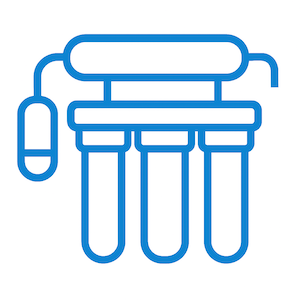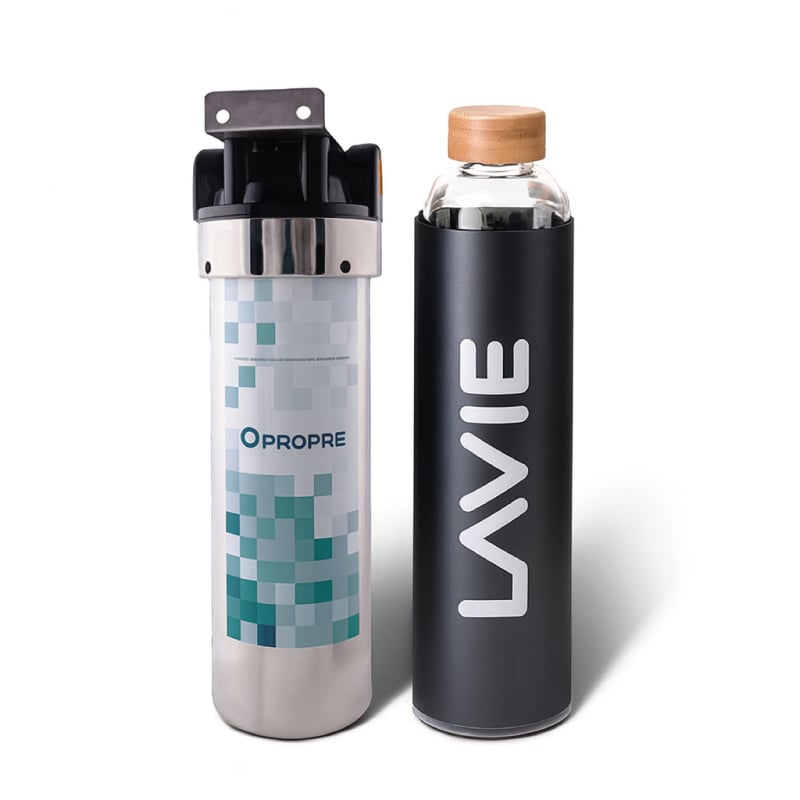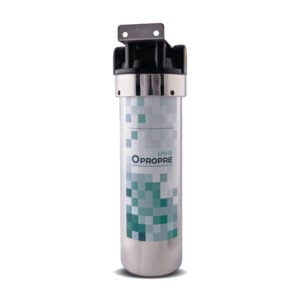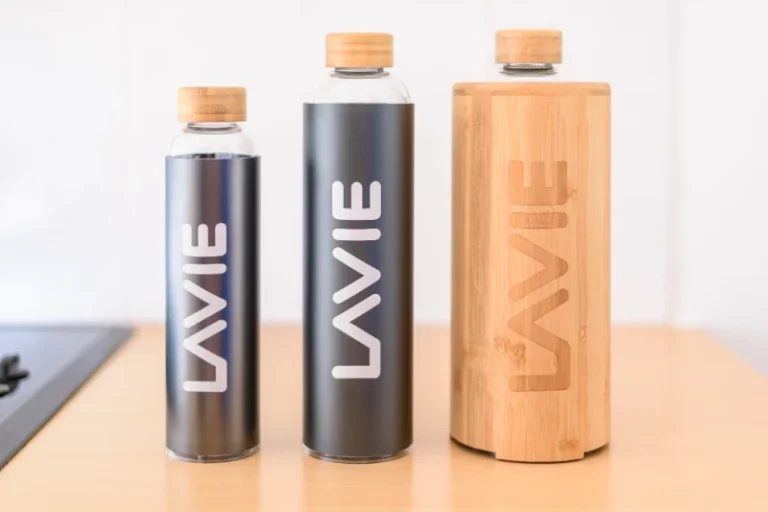
30-day money-back guarantee *

Reverse osmosis has all the hallmarks of a miracle solution: it eliminates up to 99 % of pollutants present in tap water. On paper, it sounds like a dream. But before you go out and buy a osmosis unit for filtering tap waterIt's best to be aware of the limits.
Demineralised water, acidity, wastage, onerous maintenance, high cost... This highly efficient filtration system raises a number of problems and important issues for your health and the environment.
In this article, we take a look at the advantages, disadvantages and, above all, the healthier and more sustainable purification alternatives to consider for your home.
Unlike conventional filters, reverse osmosis treatment is based on a highly advanced process Water is forced at high pressure through a membrane made up of several layers, capable of retaining virtually all undesirable substances.
The result: formidable efficiency. Reverse osmosis can eliminate up to 99 % of pollutants such as nitrates, pesticides, heavy metals, drug residues, chlorine, viruses, certain bacteria and even the bacteria that cause cancer. PFASThese eternal pollutants are now at the heart of health concerns.
It is one of the most complete purification systems on the market, used in industry as well as in some homes.
The main reason why reverse osmosis is so popular is because of its high level of safety. particularly high filtrationThis is far superior to other systems on the market. Its membrane eliminates a wide variety of impurities and pollutants, including the most stubborn: nitrates, pesticides, heavy metals, drug residues and PFAS. The result is virtually pure water, free of most undesirable substances.
It is also a process that is appreciated for its ability to produce neutral water, without taste or odour, which can be reassuring for those who are sensitive to the taste of chlorine.
On paper, reverse osmosis seems to address many of the concerns about the quality of tap water. But this is not quite the case.
While reverse osmosis shines in terms of its technical purification performance, it also raises a number of issues. practical, ecological and health issues. At first glance, these limitations may seem inconspicuous, but they can have a major impact when it comes to making a decision. choosing a filtration system for your everyday water.
The desire for perfectly pure water eliminates natural benefits. Reverse osmosis treatment eliminates almost everything with its membrane: pollutants, impurities, but also essential minerals such as calcium, magnesium and potassium. These elements play a fundamental role in many metabolic functions. Their absence, when demineralised water is consumed on a daily basis, can unbalance the body over the long term. As a resultwater filtered by reverse osmosis is not without danger for your health.
The magazine 60 Millions de consommateurs warns against the harmful effects of water produced by reverse osmosis. In his analyses, he clearly advises against its consumption and does not hesitate to use strong language, even going so far as to headline: "Osmosis water: a scam and a danger.
Another consequence is acidity. Deprived of its alkaline minerals, osmosis water becomes more acidic. And water that is too acidic can disrupt digestion, weaken the body and impair certain vital functions.
To compensate for this demineralisation, some osmosis systems incorporate a remineralisation system. But these additions never restore the natural richness of balanced water. Moreover, mineral levels remain well below WHO recommendations.
Read also : Does reverse osmosis make water unsafe to drink?
Behind its promise of purity, the osmosis unit conceals a real ecological cost. To obtain a single litre of osmosis water, it can discharge up to 4 litres of water into the pipes. This discharge, known as 'brine', is far from harmless: it is concentrated in pollutants such as heavy metals, pesticides and PFAS.
As a result, the polluted water goes straight back into the network, without being treated. That's the last straw for a solution that's supposed to protect our health. On a household scale, this represents hundreds of litres of drinking water wasted every week. A real ecological nonsense.
Reverse osmosis treatment offers a very high level of purification, the flow remains slow. Depending on the models and pressure available, a domestic reverse osmosis unit can produce between 2 and 10 litres of water per hour. This is often not enough to meet a household's needs, especially when it comes to drinking, cooking or preparing several litres in a short space of time.
Clearly, if you want "pure" water, you have to wait. This slower pace can quickly become restrictive on a daily basis, particularly for families or for repeated use during the day.
Reverse osmosis means a substantial budget. Expect to pay several hundred euros for a high-performance model. And that's just for starters! Then there are the installation costs, usually carried out by a professional. Then there are the regular replacements: filters, membranes, remineralisation cartridges, etc. Of course, none of these elements can be recycled, unfortunately.
Maintenance is carried out several times a year, often with the help of a specialist, and is therefore invoiced.
In the end, behind the promise of pure water, it's a demanding system that can quickly put a strain on the wallet.
To protect its membrane, reverse osmosis removes chlorine from the first filtration stage. But this has harmful consequences. The further the water progresses through the circuit, the more vulnerable it becomes, as it is deprived of its natural disinfectant.
Then, by stagnating in tanks, pipes or taps, it becomes a breeding ground for growth of bacteria and mouldespecially if maintenance is neglected.
It's a paradox: the 'purer' the water, the more likely it is to encourage bacterial proliferation. This is certainly not what we expect from so-called purified water.
In the vast majority of cases, treatment with reverse osmosis is not necessary. In France, tap water is safe to drink, carefully monitored and complies with health standards. This system can only be justified in specific situations, for example if an analysis reveals significant contamination with heavy metals, PFAS, nitrates or pesticides.
But for most households, it remains useless, expensive, complex to maintain, polluting and even problematic for the body.
Fortunately, there are now more natural purification solutionsSimple, ecological and just as effective, capable of responding positively to expectations in terms of health, the economy and the environment.
Reverse osmosis may be attractive because of its effectiveness on water, but it is restrictive to use, costly to maintain and not very environmentally friendly. In contrast, LAVIE offers innovative solutionsOur products are simpler, healthier and designed to respect both your health and that of the planet.
|
Element filtered, reduced or eliminated |
Classic carafe filter |
Tap filter |

Osmosis unit |

Opropre under-sink filter |

LAVIE Purifier |

Peace of mind pack (Opropre + LAVIE PURE) |
| Chlorine | ✅ | ✅ | ✅ | ✅ | ✅ | ✅ |
| Sediment | ✅ | 🟠 | ✅ | ✅ | ❌ | ✅ |
| Bacteria | ❌ | ❌ | ❌ | ❌ | ✅ | ✅ |
| Virus | ❌ | ❌ | ❌ | ❌ | ✅ | ✅ |
| Medicines | ❌ | ❌ | ✅ | ✅ | ✅ | ✅ |
| Pesticides | ❌ | ❌ | ✅ | ✅ | ✅ | ✅ |
| Heavy metals | 🟠 | 🟠 | ✅ | ✅ | ❌ | ✅ |
| PFAS | ❌ | ❌ | ✅ | ✅ | ❌ | ✅ |
| Microplastics | ❌ | ❌ | ✅ | ✅ | ❌ | ✅ |
| Mineral conservation beneficial |
❌ | 🟠 | ❌ | ✅ | ✅ | ✅ |
| Discover | Discover | Discover |
The Opropre range of under-sink filters pushes back the limits of domestic filtration. Their system is based on coconut activated carbon that effectively eliminates chlorine, heavy metals, pesticides, microplastics and other contaminants while preserving the minerals essential to the body.
The Turquoise model incorporates a specific ion exchange resin that targets the most stubborn pollutants, in particular PFAS, which are responsible for many health concerns.
Their strength also lies in their design: a returnable, refillable and recyclable cartridge and resin, to be returned to LAVIE every 6 months. Result: less waste.
Easy to install, long-lasting and with no waste water, these filters are an ecological, high-performance solution for healthy, high-quality water straight from the tap.
To find out more, read our article comparing the best under-sink filter.

While reverse osmosis seems to filter everything by applying high pressure to the membrane, it does so at the cost of many compromises. LAVIE purifiers, on the other hand, rely on systems that are gentler, healthier and much more sustainable.
Designed for everyday use, the UV-A filter carafe is based on patented technology that uses light to purify water impurities. It works simply. It effectively eliminates pesticides, chlorine, drug residues, bacteria and viruses, while preserving the minerals essential to the body's equilibrium. No filters, no disposable plastic and no water wastage.
And to take things even further, the Opropre under-sink filters act upstream on the water, complementing it. Thanks to a cartridge and a targeted, returnable, refillable and recyclable resin, they capture the most stubborn pollutants, including PFAS, which the LAVIE carafe alone cannot treat.
Finally, for large families or workplaces, LaFontaine offers a tailored solution: up to 5 litres of purified water in one go, without chemicals, cartridges or waste.
Effective, high-quality, healthy and long-lasting purification, without the constraints of reverse osmosis.

Faced with the promise of absolutely pure water, reverse osmosis treatment can be seductive, but at what price? It's expensive, time-consuming, generates waste and can sometimes be a hassle. health hazardThis technology goes too far for a need that, in reality, does not necessarily require it.
Alternatives such as UV-A filter jugs and Opropre filters offer a healthier, more balanced and much more responsible solution, without compromising your health, the environment or your budget.
With LAVIE products, you choose simple, long-lasting, quality moisturising for the whole family.
An osmosis machine uses the principle of reverse osmosis to purify water of impurities and pollutants. The water, under high pressure, first goes through a pre-filtration process (sediment, chlorine, etc.), then passes through a semi-permeable membrane that retains most of the pollutants (heavy metals, bacteria, pesticides, PFAS, etc.). Finally, a post-filter improves the taste. The result is very pure but demineralised water.
Reverse osmosis treatment has a number of disadvantages: it eliminates essential minerals, makes the water more acidic, rejects 2 to 4 litres of water for every litre of osmosis water, and requires complex installation and regular maintenance. Deprived of chlorine, the water also becomes more vulnerable to bacteria. All at a high cost.
A good osmosis system costs between €300 and €700 to buy, not including installation. Then there are the consumables (filters, membranes, cartridges, etc.) and maintenance, several times a year. Over the long term, this system can represent a substantial budget.
Drinking reverse osmosis water over the long term can cause problems. Very pure, it is also demineralised and more acidic. It can unbalance the body if consumed regularly. So it's not an ideal process for daily hydration, especially for vulnerable people.
Depending on the model, a domestic osmosis machine can reject up to 4 litres of water (or even more) for each litre purified. This waste water, concentrated in pollutants, is sent directly down the drain, which raises real environmental issues.
Want to keep up to date with our water-related articles?
Subscribe to our Newsletter below
and get -5% on your first order!